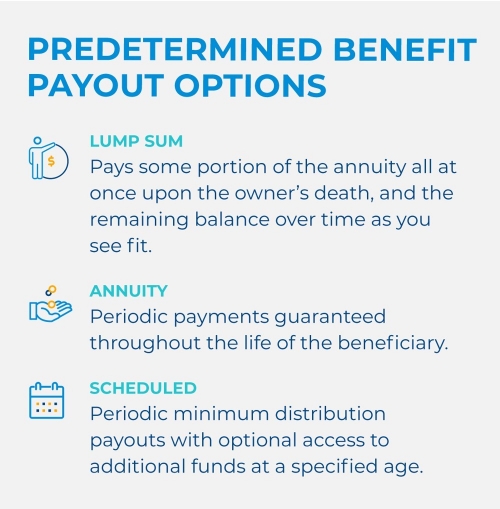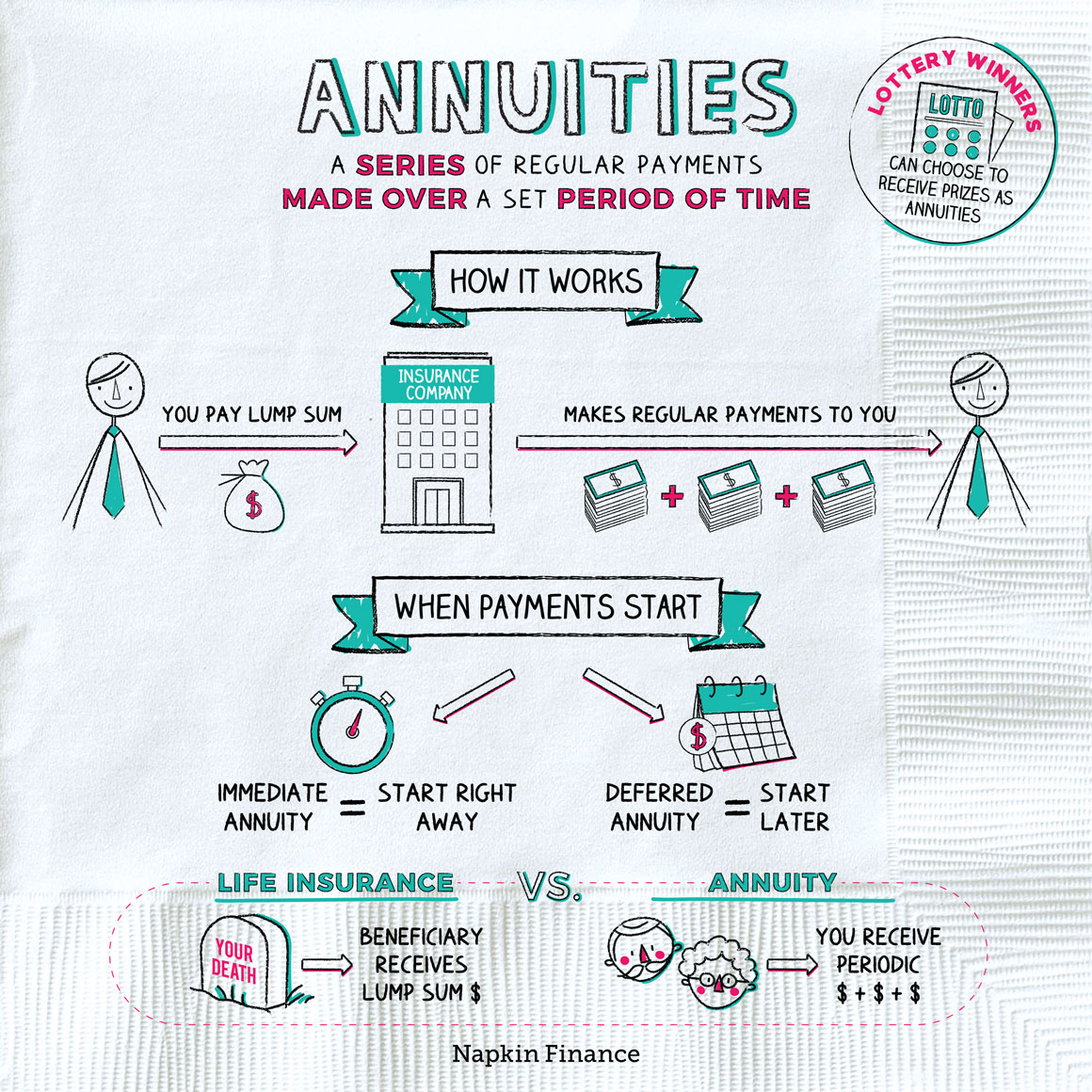All Categories
Featured
Table of Contents

Comprehending the different fatality advantage choices within your inherited annuity is important. Thoroughly examine the agreement information or speak to an economic consultant to figure out the specific terms and the best way to wage your inheritance. Once you inherit an annuity, you have several choices for obtaining the cash.
Sometimes, you could be able to roll the annuity into a special kind of private retirement account (INDIVIDUAL RETIREMENT ACCOUNT). You can select to receive the whole continuing to be equilibrium of the annuity in a solitary repayment. This option uses prompt access to the funds but comes with significant tax effects.

If the inherited annuity is a qualified annuity (that is, it's held within a tax-advantaged retired life account), you might be able to roll it over into a brand-new retired life account (Immediate annuities). You do not need to pay taxes on the rolled over amount.
Are inherited Lifetime Annuities taxable income
While you can't make extra payments to the account, an inherited Individual retirement account provides a valuable benefit: Tax-deferred development. When you do take withdrawals, you'll report annuity revenue in the same means the strategy individual would have reported it, according to the Internal revenue service.
This alternative supplies a consistent stream of income, which can be valuable for lasting economic planning. Usually, you should begin taking distributions no a lot more than one year after the owner's fatality.

As a recipient, you will not be subject to the 10 percent IRS early withdrawal fine if you're under age 59. Trying to compute tax obligations on an inherited annuity can really feel complex, yet the core principle rotates around whether the contributed funds were previously taxed.: These annuities are moneyed with after-tax dollars, so the recipient generally doesn't owe tax obligations on the initial payments, yet any profits collected within the account that are distributed undergo ordinary revenue tax.
Inherited Period Certain Annuities taxation rules
There are exceptions for partners that acquire qualified annuities. They can normally roll the funds right into their own IRA and postpone taxes on future withdrawals. Either means, at the end of the year the annuity business will file a Type 1099-R that demonstrates how much, if any kind of, of that tax year's circulation is taxed.
These tax obligations target the deceased's complete estate, not simply the annuity. These taxes generally just effect very huge estates, so for many heirs, the focus should be on the revenue tax implications of the annuity.
Inherited Annuity Payouts tax liability
Tax Obligation Treatment Upon Death The tax obligation therapy of an annuity's death and survivor benefits is can be quite made complex. Upon a contractholder's (or annuitant's) fatality, the annuity may be subject to both earnings tax and inheritance tax. There are different tax therapies depending upon that the recipient is, whether the proprietor annuitized the account, the payment method chosen by the beneficiary, and so on.
Estate Taxation The government inheritance tax is a very dynamic tax (there are several tax obligation brackets, each with a higher price) with prices as high as 55% for large estates. Upon fatality, the internal revenue service will certainly include all residential or commercial property over which the decedent had control at the time of death.
Any kind of tax obligation in unwanted of the unified credit scores is due and payable 9 months after the decedent's death. The unified credit rating will totally shelter relatively moderate estates from this tax obligation. For several clients, estate tax might not be an important concern. For bigger estates, however, estate taxes can impose a large concern.
This conversation will concentrate on the inheritance tax treatment of annuities. As was the situation throughout the contractholder's life time, the internal revenue service makes an important difference in between annuities held by a decedent that remain in the accumulation stage and those that have actually gotten in the annuity (or payment) stage. If the annuity is in the accumulation phase, i.e., the decedent has actually not yet annuitized the agreement; the full survivor benefit ensured by the contract (consisting of any boosted survivor benefit) will certainly be included in the taxable estate.
Inherited Single Premium Annuities tax liability
Example 1: Dorothy owned a fixed annuity agreement provided by ABC Annuity Firm at the time of her death. When she annuitized the contract twelve years earlier, she chose a life annuity with 15-year period certain. The annuity has actually been paying her $1,200 monthly. Since the contract warranties settlements for a minimum of 15 years, this leaves three years of settlements to be made to her kid, Ron, her marked recipient (Variable annuities).

That worth will certainly be included in Dorothy's estate for tax functions. Upon her fatality, the payments stop-- there is nothing to be paid to Ron, so there is nothing to consist of in her estate.
Two years ago he annuitized the account picking a life time with cash refund payout option, calling his little girl Cindy as beneficiary. At the time of his fatality, there was $40,000 principal staying in the contract. XYZ will certainly pay Cindy the $40,000 and Ed's administrator will certainly consist of that amount on Ed's inheritance tax return.
Since Geraldine and Miles were wed, the advantages payable to Geraldine stand for building passing to a surviving partner. Long-term annuities. The estate will be able to use the limitless marital reduction to prevent taxation of these annuity benefits (the worth of the advantages will certainly be detailed on the estate tax obligation type, in addition to an offsetting marriage reduction)
Is an inherited Flexible Premium Annuities taxable
In this situation, Miles' estate would certainly include the worth of the staying annuity repayments, however there would certainly be no marital reduction to balance out that addition. The same would apply if this were Gerald and Miles, a same-sex pair. Please keep in mind that the annuity's remaining worth is identified at the time of death.

Annuity contracts can be either "annuitant-driven" or "owner-driven". These terms refer to whose death will certainly trigger payment of fatality advantages.
But there are circumstances in which a single person possesses the agreement, and the determining life (the annuitant) is someone else. It would certainly behave to think that a certain agreement is either owner-driven or annuitant-driven, yet it is not that straightforward. All annuity contracts issued because January 18, 1985 are owner-driven since no annuity agreements issued given that after that will certainly be given tax-deferred status unless it contains language that activates a payment upon the contractholder's death.
Table of Contents
Latest Posts
Analyzing What Is A Variable Annuity Vs A Fixed Annuity Key Insights on Your Financial Future What Is Choosing Between Fixed Annuity And Variable Annuity? Features of Fixed Vs Variable Annuity Pros Co
Breaking Down Fixed Vs Variable Annuity A Comprehensive Guide to Investment Choices What Is the Best Retirement Option? Advantages and Disadvantages of Different Retirement Plans Why Choosing the Righ
Decoding How Investment Plans Work Everything You Need to Know About Financial Strategies Defining the Right Financial Strategy Pros and Cons of Various Financial Options Why Variable Vs Fixed Annuiti
More
Latest Posts